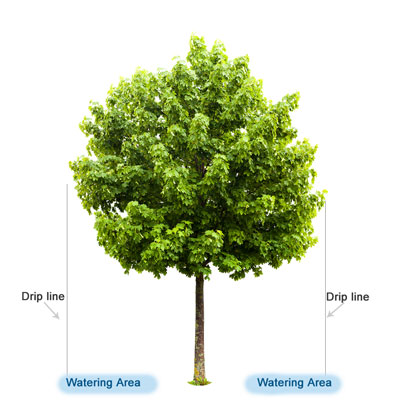It’s summer, which means warmer temperatures – and lots of thunderstorms. So with all of the rain that we’ve been getting, trees don’t need to be watered, right? Well, that depends.
Rain from our summer storms tends to fall rather quickly, with more rain running off into ditches and sewers than being absorbed into the soil. And with tree roots several inches below the surface, they might not actually see much of that rainwater.
The key to watering trees is to water deeply – meaning that it may take longer than our typical thunderstorms for enough water to seep into the ground.
How do I know if my trees need water?
If the tree was planted within the last two years, it’s going to need more water. It takes a lot of energy for roots to grow into the ground and establish themselves, and water helps trees absorb the nutrients they need for that extra energy.
You can also check how moist your soil is using either the “screwdriver test” or digging with a trowel.
Testing Moisture With a Screwdriver – Take a long screwdriver (at least eight inches) and try to drive it into the ground. If it is met with resistance, the ground is too dry and the tree should be watered. In well-watered soil, you should be able to easily push the screwdriver at least six inches into the ground.
Using a Trowel to Measure Soil Moisture – Another test is to push a trowel into the ground and move it back and forth, creating a small hole about two to four inches deep. Then, take your finger and touch the soil at the bottom of the hole. If it’s dry, you should water. If it’s moist, the tree is sufficiently watered for the moment. Note that the soil should be moist, but not soggy.
Mid to late summer is when trees are generally in the most need of watering, as the high temperatures lead to evaporation and the water stored in the soil from the winter is depleted.
What about older trees?
Well-established trees (those that have been planted for more than two or three years) will probably not need to be watered except in times of drought. But if you notice leaves yellowing, turning brittle or falling prematurely, be sure to check that your soil is moist. If not, even established trees will need an extra drink or two.
Here’s how to identify the signs of heat stress in trees >>
How should I water my trees?
The leaves of trees and plants do not need to be watered, but the roots, located under the soil, do.
Slow and deep watering is best, as it takes time to reach the tree roots under the surface. While there are many methods to do this, drip irrigation is the preferred method. Sprinklers lose much of their water to evaporation and reach the leaves more than the roots. You can use a garden hose set on a slow trickle, but be sure to move it often so that all sides of the tree are evenly watered.

Water trees around the drip line, not up against the trunk.
Don’t water near the trunk of a tree – that’s not where the roots are and keeping the trunk wet can cause it to rot. Instead, look where the canopy of the leaves ends (how far out the branches extend) and water in a circle directly below that.
The best time to water is early in the morning. Watering during the hotter parts of the day (10 am to 6 pm) leads to water evaporation instead of soaking into the ground.
Frequency of watering depends on the age of the tree. For younger trees, you may need to water up to a few times a week, especially in times of drought. For more established trees, you will water less frequently, keeping an eye on the moistness of the soil, the weather, and the health of your trees.
A general rule of thumb is to provide 10 gallons of water for each inch of the tree trunk’s diameter. A garden hose running at medium pressure will produce 10 gallons of water in about 5 minutes. Drip irrigation takes longer, and might take a few hours. (Remember, watering slowly but deeply is preferred).
Is there such a thing as watering too much?
Absolutely. In fact, it is a common tree-watering mistake. Roots can suffocate if they’re constantly sitting in water, and rot and disease can take over. Watering deeply but not frequently should allow the ground enough time to dry out a little in between watering periods. Young trees should be watered, at most, three times a week, and older trees shouldn’t need watering more than every two weeks.
What’s the deal with mulch?
Mulch can be a great help in keeping your trees hydrated – but only if it’s used properly.
Organic mulch (such as wood chips) can keep the ground around your tree moist longer than soil that’s not covered with mulch. Be sure that when you’re watering, however, you’re not just watering the mulch. The water needs to move past the moisture-absorbing mulch into the ground (and eventually the roots) below it. Use the screwdriver or the trowel test to move aside a section of mulch and test the ground below.
Additionally, ensure that the mulch is not suffocating your tree. Keep it away from the tree trunk (it should not touch the trunk or any branches), and especially avoid “mulch volcanoes,” where the mulch is piled up around the tree trunk. While you might see this technique in landscaped parks, it is actually very harmful to the tree and should be avoided (see our article on ‘Why Mulch is Killing Your Trees’). Instead, have a 2 to 3 inch evenly distributed layer of mulch in a circle around the tree, keeping an unmulched space around the tree trunk.
The benefits of mulch outweigh the negatives, however, as mulch helps a tree retain moisture and keeps soil from drying out too quickly. It also regulates the soil temperature around a tree.
Keep trees hydrated
Trees generally adapt well to their environment and circumstances, and some can last for hundreds of years if properly cared for. One of the easiest ways to ensure that your tree stays healthy is to ensure that it has enough water to thrive. Just like humans, trees can get dehydrated in the summer heat. Keeping trees well watered can keep them healthy to ward off pests and diseases.
P.S. Did you know that the “dog days of summer” actually refer to the star Sirius rising before the sun, which in ancient Greek and Roman times, was in late July? Sirius is known as the “dog star,” the nose of a dog in the constellation Canis Major.
Get helpful tips, local news, inspiring stories, and more delivered right to your inbox every month. Don't miss another issue - join today!






